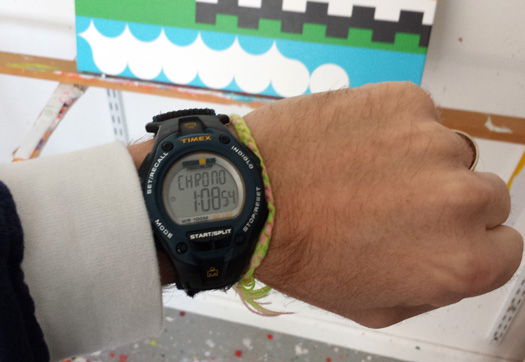Five lessons I have learned from having a goal of painting 1,500 hours in 2014
As we entered 2014, I found that I had created a New Year’s resolution for myself.
The resolution was more of a personal goal — what Jim Collins might call a “big, hairy audacious goal.”
I knew that I wanted to give my all to painting in the forthcoming year. I also knew that giving my all takes time — a commitment of time. The idea of painting (and sketching) for six hours per day popped into my mind. That’s 30 hours per week.
Extrapolating this figure over the course of a year, I realized I was staring at a goal of 1,500 hours of painting and sketching in 2014.
So there I was in my studio on January 2, with an Ironman stopwatch strapped to my wrist, pressing the start button when I got to work, pressing the stop button when I stepped away from the easel, and logging my progress into a worksheet, seeing how it all adds up. Call me a nerd? So what!
Now two weeks — 10 work days — into the year, I have logged 27.5 hours of creative time. Unfortunately, that’s already more than 30 hours behind my six-hours-per-day target. However, on a positive note, I have already completed three wall-worthy paintings.
Four lessons I have learned so far
As you’d expect, I’ve even more keenly aware of how I invest my time. I feel like a football (soccer) referee keeping time in a match. But I’ve also unexpectedly learned several subtle lessons.
1. Get to work. Second-guess less.
Perhaps most importantly, I’ve really cut down on how much I second-guess my work in general. I’m more likely to turn my sketches into paintings, sooner. In the past, there had moments when I have endlessly tinkered with a good design for a painting. One time in particular, a sketch went through 20 iterations, which turned out to be an exercise in diminishing returns. In retrospect, the first sketch was pretty good — good enough to be painted.
Now, by contrast, I feel like the process of working — simply sitting down at the table, computer, or easel — is more important when the stopwatch is running. Not every painting I make will be great, or good, for that matter. Yet, if I can keep working, I’m more likely to make good work, and potentially great work. Even if I make minor, sub-par work here and there, I’m closer to making something good, because I keep learning as I go. The key is to keep working. Process will take of product.
2. Tracking time fosters accountability and focus.
When the stopwatch is on, it’s all about making art. A laser-like focus develops, and distractions get pushed out of the way. Checking the twitter feed is for break time. ! )
3. Keep on keeping on.
On a number of occasions, using a stopwatch has motivated me to not take a break — to keep motoring along — especially when I’m approaching an hourly milestone in a given day. If I see that I’ve painted 52 minutes so far, I somehow feel encouraged to paint another eight minutes, to “top things off” at the hour mark, and then take a quick break.
It’s a lot like doing bicep curls at the gym. No one stops at nine. You have to go for ten.
And, when I’m staring at the prospect of working on a complicated section of a painting, that same top-things-off mentality often kicks in. Rather than be stymied by the complexity of a section, I think about the smaller goal, of painting just a few minutes to get started. In turn, the complex section seems to break into more manageable parts.
4. It all adds up.
The stopwatch has certainly helped me realize how effort adds up. In the past, I often wondered whether I was painting enough. For whatever reason, I thought I was being lazy. Now that I’m accounting for my creative time, I’m easier on myself, because I’m able to remind myself of what I have already accomplished. It’s much easier to say “I’m doing the best I can, given my resources, circumstances and obligations.”
5. Compartmentalization has its benefits.
Fifth and finally, when I take a break, or move on to other work (such as unrelated consulting services I provide for clients), I feel more able to shut out pressures related to my creative work. A football match seems more enjoyable when the creative work is on hold.
Too big of a goal? To be determined.
Ultimately, I might be overreaching with my goal of 1,500 creative hours this year. A goal of 1,200 or 1,000 hours might be more realistic. After all, I have client work to do, and there are many other things to do. I enjoy posting my work to social streams. Life in general needs to be attended to. The value of visiting with friends and family cannot be overstated.
The key is finding ways to focus, while maintaining a balance. When I reach the end of January, I’ll revisit my progress, and consider adjusting my BHAG for 2014 accordingly.
Have you experimented with keeping track of your art-making activities? Share your story below.
